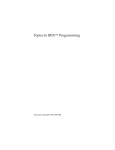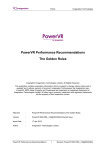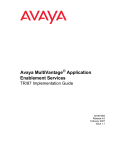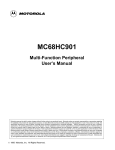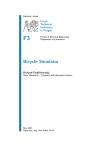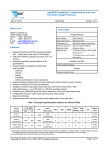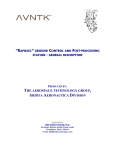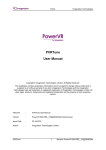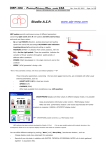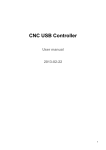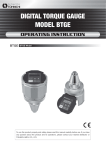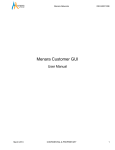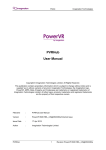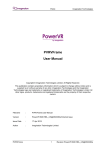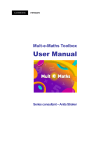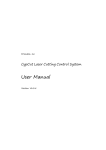Download PowerVR Performance Recommendations
Transcript
Proprietary
Imagination Technologies
PowerVR
Performance Recommendations
Copyright © Imagination Technologies Ltd. All Rights Reserved.
This publication contains proprietary information which is subject to change without notice and is
supplied 'as is' without warranty of any kind. Imagination Technologies and the Imagination
Technologies logo are trademarks or registered trademarks of Imagination Technologies Limited. All
other logos, products, trademarks and registered trademarks are the property of their respective
owners.
Filename
:
PowerVR.Performance Recommendations.1.0.3.External.doc
Version
:
1.0.3 External Issue (Package: PowerVR SDK REL_3.0@2149525)
Issue Date
:
30 Aug 2012
Author
:
Imagination Technologies Ltd
PowerVR
1
Revision .
Imagination Technologies
Proprietary
Contents
1.
Introduction .................................................................................................................................4
1.1.
Document Overview ...........................................................................................................4
2.
Optimal Development Approach ...............................................................................................5
2.1.
Understanding Rendering Bottlenecks...............................................................................5
3.
The Golden Rules .......................................................................................................................6
3.1.
Understand Your Target Device .........................................................................................6
3.2.
The Principle of ‘Good Enough’..........................................................................................7
3.2.1.
Examples..................................................................................................................7
3.3.
Profile, Profile, Profile! ........................................................................................................7
3.4.
Promote Calculations up ‘The Chain’ .................................................................................8
3.5.
Avoid Accessing Render Targets .......................................................................................8
3.5.1.
Accessing Render Targets Safely............................................................................9
3.6.
Avoid Using Alpha Test/Discard .......................................................................................10
3.7.
Use EXT_discard_framebuffer and Clear ........................................................................10
3.8.
Take Advantage of HSR...................................................................................................10
3.8.1.
Opaque, Alpha Test, Alpha Blend..........................................................................10
3.9.
Batch, Batch, Batch! .........................................................................................................11
3.9.1.
Minimize State Changes ........................................................................................11
3.9.2.
Group Meshes ........................................................................................................11
3.9.3.
Instancing (Series 6 Only) ......................................................................................11
3.9.4.
Texture Atlases ......................................................................................................11
3.10.
Perform Rough Culling .....................................................................................................12
3.11.
Target a Sensible Frame Rate .........................................................................................12
3.12.
Favour Stencil Operations ................................................................................................13
3.12.1.
Is the Stencil Operation Required? ........................................................................13
3.12.2.
Where is the Performance Bottleneck?..................................................................13
3.12.3.
Re-Implementing Using Stencil Operations ...........................................................13
4.
Optimizing Geometry................................................................................................................14
4.1.
Geometry Complexity .......................................................................................................14
4.2.
Primitive Type ...................................................................................................................14
4.3.
Data Types .......................................................................................................................14
4.3.1.
‘Fixed’ Data Types..................................................................................................14
4.4.
Interleaving Attributes .......................................................................................................14
4.5.
Vertex Buffer Objects .......................................................................................................15
4.6.
Padding.............................................................................................................................15
5.
Optimizing Textures .................................................................................................................16
5.1.
Texture Size......................................................................................................................16
5.2.
Texture Compression .......................................................................................................16
5.2.1.
Why use PVRTC? ..................................................................................................17
5.2.2.
Image File Compression versus Texture Compression .........................................18
5.3.
MIP-Mapping ....................................................................................................................20
5.4.
Texture Sampling..............................................................................................................21
5.4.1.
Texture Filtering .....................................................................................................21
5.4.2.
Dependent Texture Reads (Series 5/5XT Only) ....................................................21
5.4.3.
Wide Floating Point Textures .................................................................................21
5.5.
Demystifying NPOT ..........................................................................................................22
5.5.1.
SGX Support ..........................................................................................................22
5.5.2.
GL_IMG_texture_npot............................................................................................22
5.5.3.
Guidelines ..............................................................................................................22
5.6.
Texture Uploading ............................................................................................................23
5.6.1.
Texture Warm-up ...................................................................................................23
5.6.2.
Texture Formats and Precision ..............................................................................23
5.7.
Render To Texture............................................................................................................23
5.8.
Mathematical Look-ups (Series 5/5XT Only)....................................................................23
Revision .
2
Performance Recommendations
Proprietary
Imagination Technologies
6.
Optimizing Shaders ..................................................................................................................24
6.1.
Choose the Right Algorithm..............................................................................................24
6.2.
Know Your Spaces ...........................................................................................................24
6.3.
Flow Control......................................................................................................................24
6.4.
Demystifying Precision .....................................................................................................25
6.4.1.
Highp ......................................................................................................................25
6.4.2.
Mediump.................................................................................................................25
6.4.3.
Lowp (Series 5/5XT Only) ......................................................................................25
6.4.4.
Attributes ................................................................................................................25
6.4.5.
Varyings..................................................................................................................26
6.4.6.
Samplers ................................................................................................................26
6.4.7.
Uniforms .................................................................................................................26
6.4.8.
Conversion Costs ...................................................................................................26
6.5.
Scalar Operations .............................................................................................................27
6.6.
Sparse Matrices................................................................................................................27
6.7.
‘Const’ Data in Shaders ....................................................................................................27
7.
Optimizing Specific Techniques .............................................................................................28
7.1.
Multiple Render Targets (Series 6 Only) ..........................................................................28
7.2.
Efficient Sprite Rendering.................................................................................................28
8.
Related Materials ......................................................................................................................29
9.
Contact Details..........................................................................................................................30
List of Figures
Figure 2-1 Cyclical Profiling .................................................................................................................... 5
Figure 3-1 Generalisation of ‘The Chain’ ................................................................................................ 8
Figure 3-2 Serialised Render Target Access .......................................................................................... 8
Figure 3-3 Implementation of Render Target Access using EGL_KHR_fence_sync ............................. 9
Figure 3-4 Rough Culling ...................................................................................................................... 12
Figure 5-1 Image File Compression vs. Texture Compression ............................................................ 19
Figure7-1 Increasing complexity and reducing processing................................................................... 28
PowerVR
3
Revision .
Imagination Technologies
Proprietary
1. Introduction
PowerVR Series 5, and Series 6, are families of GPU cores from Imagination Technologies designed
specifically for shader-based APIs like OpenGL ES 2.0 & 3.0. Due to their scalable architectures, the
PowerVR family spans a huge performance range.
1.1.
Document Overview
The purpose of this document is to serve as recommendation and advice for developers who wish to
get the best graphics performance from a PowerVR Series 5 or Series 6 enabled device. Where
recommendations are different from Series 5 to Series 6 they will be marked as such.
Revision .
4
Performance Recommendations
Proprietary
Imagination Technologies
2. Optimal Development Approach
Ideally, a developer should aim to implement their application while obeying all (or as many as
possible) of the techniques detailed in Section 3 The Golden Rules. It is crucial to adopt some of the
practices detailed in this document from the very start of development in order to save much time and
effort later.
Once an application is implemented to a level approaching its final state then a process of iteration
should be adopted:
Figure 2-1 Cyclical Profiling
The main benefit of this approach is that time is not wasted and graphics quality not comprised by
making changes that do not benefit performance.
2.1.
Understanding Rendering Bottlenecks
It is a common misconception that the same actions can speed up any application. For example:
•
Polygon Count Reduction
If the bottleneck of the application is fragment processing or texture bandwidth then the only
result of this action will be to reduce the graphical quality of the application without improving
rendering speed. In fact, if simpler models actually cause more of the render target to be
covered by a material with complex fragments then this can actually slow down an application.
•
Reduce Rendering Resolution
In this case, if the fragment processing workload of your application is not the bottleneck then
this will also only serve to reduce the quality of the graphics in your application without
improving performance.
In reality, it is only once the limiting factor of an application is determined by profiling with the correct
tools that optimization work should be applied. It is also important to realise that once work has been
done then the application requires re-profiling in order to determine whether the work actually
improved performance and whether the bottleneck is still in the same stage of the graphics pipeline. It
may be that the limiting stage in rendering is now in a different place and further optimization should
be targeted accordingly.
PowerVR
5
Revision .
Imagination Technologies
Proprietary
3. The Golden Rules
As mentioned in Section 2 Optimal Development Approach, developers should seek to implement and
observe as many of the techniques and principles mentioned in these rules as possible, right from the
start of development in order to produce well-behaved, high performance graphics applications.
3.1.
Understand Your Target Device
No two mobile devices are identical and no two graphics architectures are the same.
Even when the GPU architecture being targeted is thoroughly understood it is important to remember
that no two System-on-Chips (SoCs) have exactly the same capability; some may have more powerful
CPUs, others may have greater availability of bandwidth etc.
Even between two otherwise identical devices, as SoCs share memory between components, it is
possible for applications to be slowed down by other applications being run in the background,
especially in regards to memory bandwidth.
The Tile Based Deferred Rendering (TBDR) system used in PowerVR hardware already helps to
relieve some of these issues by ensuring memory access is kept to a minimum but it is still vitally
important that developers take these factors into account. Finally, in order to sensibly benchmark and
recognise what bottlenecks may exist, a developer must possess, as has already been stated, a
thorough understanding of the architecture being targeted; to this end an ‘Architecture Guide for
Developers’ is provided in the PowerVR Insider SDK and through the Developer section of the
Imagination website.
Developers should seek to learn as much information about their target platforms and where they may
differ as possible. The manufacturers’ websites for devices may be a good place to look for
specifications and they may also provide developer community resources that can be helpful.
Revision .
6
Performance Recommendations
Proprietary
3.2.
Imagination Technologies
The Principle of ‘Good Enough’
Real time graphics can only achieve a finite level of image fidelity per frame whilst maintaining a
reasonable frame rate – the more complex a frame the slower it can be rendered. This means that a
compromise has to be made between image quality or “correctness” and speed of rendering. While
making this compromise it is important to remember that rendering is only as valuable as the quality
perceived by the viewer and will always be an approximation - favour techniques that help improve
the perceived quality rather than use idealistic, “correct” approaches that may slow rendering
unacceptably or simply not look as good as simpler solutions. In other words, favour techniques that
are “Good Enough” in order to retain acceptable rendering speed.
3.2.1.
Examples
Alpha Blended Polygon Rendering Order
Many blend modes used when rendering transparent objects in a scene are submission orderdependent in their output. To get correct, consistent, output the fragments rendered using these
modes should be drawn in depth order, back to front. Unfortunately, sorting these transparent layers
per-fragment is difficult and prohibitively expensive. Developers solve this issue by using “good
enough” compromises, such as:
•
Sort per polygon; very expensive and problematic
•
Split objects into sub-meshes and sort; still expensive and introduces some artefacts
•
Sort by object; cheap, but artefacts are easy to uncover
Interpolated Vertex Values vs. Per Fragment Calculations
Many techniques, such as bump-mapping, may be more accurate with per-fragment calculation, but in
practice can look entirely acceptable using the results of per-vertex calculations that are interpolated
across the fragments in a polygon. This approach, due to there being fewer vertices than fragments in
a typical scene can be more efficient for “good enough” results.
Lower Bit-rate Textures
Textures that are compressed or down-sampled can look noticeably different to the developer,
particularly in the preview window of a tool such as PowerVR’s PVRTexTool GUI application. In a 3D
scene this difference often is a lot less obvious, to the extent that a user will not perceive any benefit
from the higher bitrate, more expensive versions of the textures. The smaller textures are usually
“good enough” for acceptable image quality while making a much more significant difference to
bandwidth use and hence frame rate.
3.3.
Profile, Profile, Profile!
Profiling tools are provided to developers so they can gain an understanding of what is happening in
their application, and how it relates to the hardware the application is running on. They allow
developers to determine where bottlenecks are occurring, and enable effort to be concentrated on
areas that will improve rendering performance.
Ideally, optimizations should only be targeted at bottlenecks that have been identified through
profiling; these optimizations should then be checked by re-profiling. This cyclical process, as
described in Section 2 Optimal Development Approach, ensures applications don’t fall into the trap of
cutting quality for no gain, for example, halving the number of vertices in a scene which is limited by
the complexity of the fragment shader. To this end the PowerVR Insider SDK includes a GPU
profiling tool called PVRTune; information on identifying bottlenecks with PVRTune can be found in
the PVRTune User Manual.
PowerVR
7
Revision .
Imagination Technologies
3.4.
Proprietary
Promote Calculations up ‘The Chain’
In general, fewer vertices exist in a scene than fragments appear
on the screen; as such, processing time can be saved by
performing a calculation in the vertex shader rather than in the
fragment shader. This is promoting a calculation ‘up the chain’.
Even more GPU performance can be gained by promoting a
calculation off the GPU altogether; for example, pre-building a
matrix or pre-transforming an object into view space on the CPU.
While the GPU can perform these operations very rapidly, in many
cases far more rapidly than the CPU, performing a calculation
once on the CPU is much less intensive than performing the
operation once per vertex, or once per fragment.
Pre-Baking
‘Pre-baking’ takes this concept one step further. It is likely that a
fragment shader is already reading from several textures, certain
features can be pre-baked into these textures to save time;
lighting, for example.
Figure 3-1 Generalisation of
Lookup Textures (Series 5/5XT Only)
‘The Chain’
This can be taken one step further again using the concept of
‘lookup textures’; a texture is created to act as a lookup table for a particular mathematical function.
Using this technique a mathematical function can be replaced by a texture read saving calculation
time at the expense of bandwidth. It should be noted that a significant amount of work must be saved
if this texture read would qualify as a ‘dependent’ texture read.
Due to the higher ALU power in Series 6 onwards it is unlikely this will provide a benefit.
3.5.
Avoid Accessing Render Targets
Accessing render targets from the CPU is very bad for GPU performance as it breaks the parallelism
between the CPU and the GPU:
•
Any access to the current render target will cause the driver to flush queued rendering
commands and wait for rendering to finish.
•
The CPU must wait for the flush to complete before it can access the buffer in question
•
The GPU must wait for the CPU to finish its access before it can continue working in that
buffer and may need to wait for further graphics instructions to be submitted from the
CPU.
Figure 3-2 Serialised Render Target Access
Revision .
8
Performance Recommendations
Proprietary
3.5.1.
Imagination Technologies
Accessing Render Targets Safely
If render target access cannot be avoided then steps must be taken to ensure that CPU/GPU
parallelisation is unbroken or at least that the negative effects are minimized. The recommended
means of doing this is through the use of the EGL_KHR_fence_sync extension and EGLImage
surfaces.
For details of these extensions please see their specifications, available on the Khronos website:
•
http://www.khronos.org/registry/egl/
EGL_KHR_fence_sync
The EGL_KHR_fence_sync extension introduces the concept of ‘sync objects’ into EGL. Sync
objects are a synchronisation primitive representing events whose completion can be tested for or
waited upon.
By inserting a sync object just before ‘eglSwapBuffers’ is called, it is possible to wait on that ‘fence’
being hit as a means to determine if the GPU has finished writing to a target. With the addition of a
queue of EGLImage surfaces, the CPU and GPU can both access a different render target without
blocking each other. This is done using the OES_EGL_image_external extension, an extension
designed to grant access to an area of memory shared between Khronos APIs (e.g. OpenGL ES) and
the developer’s application. An example use case for this would be the writing of video data from an
application to a buffer to be used by the OpenGL ES API, or the retrieval of the contents of a
framebuffer after writing to it has been completed.
This method should only be performed with EGLImage surfaces, all other methods, particularly those
that require (ab)using ‘glReadPixels’ to force the GPU to finish, will always block and break
parallelism as illustrated in Figure 3-2 Serialised Render Target Access.
Figure 3-3 Implementation of Render Target Access using EGL_KHR_fence_sync
PowerVR
9
Revision .
Imagination Technologies
3.6.
Proprietary
Avoid Using Alpha Test/Discard
The OpenGL ES 2.0 fragment shader operation ‘discard’ can be used to stop fragment processing
and prevent any buffer updates for the current fragment in a shader. Essentially, it provides the same
functionality as the fixed function ‘alpha test’ but in a programmable manner. It can seem like a
convenient method to achieve the rendering of complex shapes without using geometry, but it is an
expensive operation on all modern graphics hardware and thus is discouraged.
On modern graphics hardware, the use of ‘alpha test’ requires that the fragment shader be run for a
given fragment before visibility can accurately be determined. This affects performance on PowerVR
as the visibility information must be fed back from the fragment processing stage to the ISP before the
ISP can continue to perform depth and stencil tests for other polygons in that position. This effectively
removes some of the benefits of PowerVR’s Hidden Surface Removal (and those of ‘Early-Z’
techniques on other architectures).
For this reason ‘discard’ and ‘alpha test’ should be avoided whenever possible.
It should also be noted that if a shader contains the ‘discard’ keyword then any object that shader
is applied to will suffer the cost of alpha test, even if the keyword is inside a conditional block that the
developer knows will not be hit for a draw call. The GPU cannot know the result of the conditional
without executing the fragment shader and so has to assume that the ‘discard’ keyword may be
hit. The solution to this is to move the use of ‘discard’ into a separate shader.
Under fixed function APIs it is essential that ‘alpha test’ be disabled for objects that do not require it.
It is common for ‘alpha test’ to be switched on at the beginning of a scene and left on for the entire
scene. This is strongly discouraged is it may severely harm performance.
The same visual effect as ‘discard’ can often be achieved through the use of the correct Alpha
Blend Mode, and setting the Alpha value to ‘0’ where ‘discard’ would be used.
If ‘discard’ or ‘alpha test’ cannot be avoided then objects using these techniques should be
submitted after all opaque geometry is submitted.
3.7.
Use EXT_discard_framebuffer and Clear
A PowerVR core uses a TBDR architecture that allows much work (such as colour, depth or stencil
operations) to be carried out on-chip, without accessing main memory. Commonly, an application
doesn’t require the information from a frame for a subsequent render so the bandwidth used in storing
and retrieving this data is unnecessary.
The EXT_discard_framebuffer extension allows the developer to communicate to the GPU which
buffers are not going to be required after a tile has been processed. Additionally, performing a clear
operation before rendering a frame tells the GPU that it doesn’t need to retrieve stored data before
drawing a tile.
Without these calls the GPU cannot know to avoid the wasted loads and flushes in time, even if
subsequent rendering will entirely obscure any data that was previously present.
Used together, these two operations can save a great deal of unnecessary bandwidth use, and
should be used for all render targets and frame buffer objects.
3.8.
Take Advantage of HSR
Hidden Surface Removal (HSR) is the method by which PowerVR GPUs remove unnecessary work
by only processing fragments that will contribute to the final render; it is pixel perfect, and entirely
submission order independent. As such, ‘Early-Z’ passes, and sorting of geometry by depth are not
required. Instead, objects should be sorted by render state. This will help with batching (see Section
3.9 Batch, Batch, Batch!) and will improve performance and power consumption
3.8.1.
Opaque, Alpha Test, Alpha Blend
To get the maximum benefit from HSR opaque objects should be submitted first, then alpha test
objects (where this technique cannot be avoided), then alpha blended objects.
Revision .
10
Performance Recommendations
Proprietary
3.9.
Imagination Technologies
Batch, Batch, Batch!
3.9.1.
Minimize State Changes
Wherever possible, code should be structured to avoid redundant state changes. Where this is hard
to achieve, a copy of the current state can be kept in the application and a call only made if the old
state and the new state are different.
Ideally, the following rules should be followed:
•
Set every OpenGL state at most once between draw calls.
•
Set only those states that affect the next draw call.
• Don’t set states that already have the desired value.
It should also be noted that, thanks to PowerVR’s order independent, pixel-perfect, Hidden Surface
Removal, objects do not need to be ordered by depth; this allows an application to sort by render
state instead, which improves batching and minimizes state changes further. Applications should, as
a priority, sort to avoid blending state or shader changes as these are the most expensive.
3.9.2.
Group Meshes
If multiple meshes have static positions and orientations relative to one another, and could use the
same render state, they should be combined into a single mesh; this will reduce the number of draw
calls, and thus may increase performance.
3.9.3.
Instancing (Series 6 Only)
‘Instancing’ is the practice of rendering multiple copies of the same mesh in a scene at once. By
using this technique to draw repetitive geometry you can further improve batching, and thus
performance.
3.9.4.
Texture Atlases
A texture atlas is a single large texture that contains multiple sub-textures. With correctly calculated
UVs, individual areas in the texture atlas can be used like a separate texture. This approach
minimizes the number of times that textures must be rebound and hence reduces the number of draw
calls an application requires; effectively batching textures.
There are two common issues that must be considered before using a texture atlas, however. The
first of these is when using MIP-Maps. During MIP-Map generation it is possible that texels from
neighbouring areas within the texture atlas can blend into each other. Some solutions to this are to
leave a large border around each area within the texture atlas or to place areas with similar borders
next to each other.
The second issue is in the use of texture wrap modes: when performing wrapping, OpenGL’s texture
coordinates only wrap over the entire texture; there is no facility to wrap over a portion of a texture.
Solutions to this problem: ensure enough redundancy in the atlas texture to avoid discrepancies,
create a shader that will correct the UV mapping or don’t use wrapping at all.
Information on the number of OpenGL calls an application is making, and the OpenGL render state
etc., all of which relate to batching correctly, can be checked using the PVRTrace application,
available as part of the PowerVR Insider SDK.
PowerVR
11
Revision .
Imagination Technologies
3.10.
Proprietary
Perform Rough Culling
Where it is feasible to do so, rough culling should be
performed on the CPU to avoid unnecessary geometry
processing; objects that are not going to contribute to a
frame should not be submitted.
A minimal approach to this is to cull objects that are behind
the camera or otherwise outside the view frustum as these
will be clipped away by the GPU anyway. A more advanced
approach would be to use a technique such as ‘Portal
Culling’.
3.11. Target a Sensible Frame Rate
A higher framerate will improve the smoothness of any
Figure 3-4 Rough Culling
animations in an application and may improve the feel of
user interaction. Forcing a lower frame rate than the
maximum that the device is capable of will help with power consumption as less work needs to be
done by the device to render frames over the same period of time.
As a rule, if animation is on screen and needs to be updated frequently, such as during game play,
then aim to update the screen at a high, constant framerate. If no animation is visible, such as when
displaying an idle menu screen then there is no reason to render the same image over and over consider lowering the frequency of screen updates until user interaction is detected. This will allow the
device to expend less power over the same time period for the same result.
If an application is having trouble maintaining a constant framerate, say it varies between 30 and
60fps, then it may be beneficial to restrict rendering to a constant 30fps i.e. the lower end of the
varying range, as this is likely to look just as smooth to the user without expending power drawing
extra frames that don’t enhance the quality of output.
Even if an application can run at a constant high frame rate, but this high framerate doesn’t enhance
the user experience, then consider lowering the frame rate to reduce power consumption.
Alternatively, this may be an opportunity to increase the quality of graphics in the application by
increasing model complexity, texture detail, or shader sophistication.
Revision .
12
Performance Recommendations
Proprietary
Imagination Technologies
3.12. Favour Stencil Operations
Stencil operations are carried out on-chip, per tile, and so are very cheap on PowerVR hardware. In
almost every case a technique that could be performed using functions such as scissoring can also
be performed using the stencil buffer. Preferring the use of the stencil buffer in these cases will almost
always improve performance, possibly dramatically, but the following questions should be considered
first.
3.12.1.
Is the Stencil Operation Required?
It is inefficient to use unnecessary calls that won’t affect the final output; thus, if an object to be drawn
would fit entirely inside a stencil region then the stencil operation should not be used. This holds true
for other clipping operations, such as scissor.
3.12.2.
Where is the Performance Bottleneck?
As is covered in Section 2 Optimal Development Approach it is essential to verify that the code that
you wish to change is actually affecting the rendering speed of the application. If there are very few
stencil/scissor operations in your application then it is likely that more value will be gained from
optimizing elsewhere. For instance, an application that is limited by overly complex fragment shaders
is unlikely to benefit significantly from swapping scissor operations for stencil operations.
3.12.3.
Re-Implementing Using Stencil Operations
As an example, a common use case would be the use of rectangles to restrict the area of the screen
to be drawn to. This technique, normally performed with scissoring, can easily be solved using stencil
operations and this may provide a substantial boost to rendering performance.
The procedure for implementing this technique is as follows:
•
Clear the stencil buffer.
•
Render rectangles to the stencil buffer only, each rectangle representing an area that is to be
drawn to. Each rectangle should be given a unique value within the stencil buffer if
overlapping is required. If no overlapping is required, or content will not spill over the edge of
a stencil, then the same value may be used. It should be noted that submission order will
affect overlap behaviour.
•
Render content using the stencil test value corresponding to the desired rectangle so that
fragment visibility is determined by what is stored in the stencil buffer.
If more unique values are still required than the stencil buffer can contain, then the render should be
resolved up to the stage where the number of available stencil values has run out. The above
sequence should then be performed again for the remains of the scene.
Finally, one of the bonuses of using stencil operations for this technique is that, unlike scissor
methods, the stencils used can be of an arbitrary shape and size and are not just restricted to
rectangles.
PowerVR
13
Revision .
Imagination Technologies
Proprietary
4. Optimizing Geometry
4.1.
Geometry Complexity
It is important that an appropriate level of geometry complexity be used for each object or portion of
an object. It is a waste to use a large number of polygons on an object that will never cover more
than a small area of the screen. Likewise, it is a waste to use polygons for detail that will never be
seen due to camera angle, or culling; or to use large amounts for objects that may be drawn with
much fewer, such as spending hundreds of polygons drawing a single quad. Shader techniques such
as bump mapping should be considered to minimize geometry complexity, but still maintain a high
level of perceived detail. Techniques such as ‘Level of Detail’ should be used, this is especially true
for things such as reflection passes where higher amounts of geometry may not be visible.
4.2.
Primitive Type
In general, drawing a mesh as a single, indexed, triangle list will ensure the best performance on
PowerVR SGX hardware.
4.3.
Data Types
Vertex shaders always expect attributes to be of the type ‘float’, this means that all types except ‘float’
will require a conversion. This conversion is performed in the USSE pipeline and costs a few
additional cycles; thus the choice of attribute data type is a trade-off between shader cycles,
bandwidth/storage requirements and precision. It is important that type conversion is considered as
bandwidth is always at a premium.
Precision requirements should be checked carefully, the ‘byte’ and ‘short’ types are often sufficient,
even for position information. For example, scaled to a range of 10m the ‘short’ types give you a
precision of 150 µm. Scaling and biasing those attribute values to fit a certain range can often be
folded into other vertex shader calculations, e.g. multiplied into a transformation matrix.
4.3.1.
‘Fixed’ Data Types
The ‘fixed’ data type uses the same bandwidth as ‘float’, but requires additional format conversion
cycles in the USSE pipeline, thus it should be avoided.
4.4.
Interleaving Attributes
Two ways exist to store vertex data in memory, either the data is stored with all the information,
position, normals etc., pertaining to a given vertex in a single block, followed by all the information
pertaining to the next vertex, and so on; or the data can be stored in a series of arrays, each
containing all the information of a particular type for each vertex, for example, an array of positions,
an array of normals etc. The first of these two options is called ‘interleaving’.
In general data should be interleaved; this provides better cache efficiency, and thus better
performance.
Two major caveats exist to this rule. Interleaving should not be used if several meshes are to share
the same array of vertex attributes; in this case putting the instances of this attribute into their own
array may result in better performance, and will save bandwidth and storage space due to there being
less duplication.
Interleaving should also not be used if a single attribute will be updated frequently, outside of the
GPU, while the other attributes remain the same. In this instance, data that will not be updated
should be interleaved, while data that will be updated is held in a separate array.
Revision .
14
Performance Recommendations
Proprietary
4.5.
Imagination Technologies
Vertex Buffer Objects
Vertex Buffer Objects (VBO) (and, where available, Vertex Array Objects) are the preferred way of
storing vertex and index data; since VBO storage is managed by the driver there is no need to copy
an array from the client side at every draw call and the driver is able to perform some transparent
optimizations.
Pack all the vertex attributes that are required for a mesh into the same VBO unless a mixture of static
and dynamic attributes are being used. Do not create a VBO for every mesh, it is a good idea to
group meshes that are always rendered together in order to minimize buffer rebinding, this also has
the benefit of improving batching.
As the TBDR tends to process multiple frames at a time, the driver has to internally allocate multiple
buffers for dynamic VBOs so that each frame has a unique dynamic buffer associated with it. Because
dynamic VBOs cause the driver to behave in this way it's generally better for performance to resubmit
vertex data that changes on a per-frame basis. If you have a mesh where only some of the vertex
data is dynamic (for example, a skinned character in a game) then you should create a VBO that
contains the static data and use calls to glVertexAttribPointer() to resubmit the dynamic
vertex data. On a similar note, a VBO that will never change should always set ‘STATIC_DRAW’
while a VBO that whose contents will change should never set it.
4.6.
Padding
When vertex data is interleaved, each vertex should be aligned to a four byte boundary; when vertex
data is not interleaved each element in each array of vertex data should be aligned to a four byte
boundary.
PowerVR
15
Revision .
Imagination Technologies
Proprietary
5. Optimizing Textures
5.1.
Texture Size
It is a common misconception that bigger textures always look better; a 1024x1024 texture that never
takes up more than a 32x32 area of the screen is a waste of both storage space and bandwidth. A
texture’s size should be based on its usage; ideally this will be the same as the number of texels the
texture will cover when the object that it is mapped to is viewed from the closest allowable distance.
In some instances it is acceptable to use images that are bigger than the number of texels the texture
will cover on the screen. This is primarily in situations where low bit rate texture compression is being
used, but the quality of the compressed texture is not deemed to be high enough. In these instances
using a larger compressed texture may produce a more acceptable image quality, while still ensuring
bandwidth savings over uncompressed textures.
5.2.
Texture Compression
Modern applications have become graphically intensive; certain types of software, such as games or
navigation aids, often need large amounts of textures in order to represent a scene with satisfying
quality. Texture compression can save or allow better utilization of bandwidth, power, and memory
without noticeably losing graphical quality and should be used as much as possible. PowerVR
hardware offers a specific form of texture compression called ‘PVRTC’ which should be used as much
as possible.
PVRTC is PowerVR’s proprietary texture compression scheme. It uses a sophisticated amplitude
modulation scheme to compress textures: texture data is encoded as two low-resolution images along
with a full resolution, low bit-precision modulation signal. More information can be found in the
whitepaper:
Fenney, S. (2003) 'Texture Compression Using Low-Frequency Signal Modulation' SIGGRAPH
Conference.
Additionally, it supports both opaque (RGB) and translucent (RGBA) textures (unlike other formats,
such as S3TC, that require a dedicated, larger form to support full alpha channels); and boasts a very
high image quality for competitive compression ratios: 4 bits per pixel (PVRTC 4bpp) and 2 bits per
pixel (PVRTC 2bpp). At time of writing, no other format is available in hardware at such a low bit rate.
Revision .
16
Performance Recommendations
Proprietary
5.2.1.
Imagination Technologies
Why use PVRTC?
In any given situation, the best texture format to use is the one that gives the required image quality at
the highest rate of compression. The smaller the size of the texture data, the less bandwidth is
required for texture fetches; this reduces power consumption, can increase performance, and allows
for more textures to be used for the same budget. The smallest RGB and RGBA format currently
available is PVRTC 2bpp; as such, it should be considered for every texture in an application. Larger
formats (such as PVRTC 4bpp) should only be used if the image quality provided by a particular
PVRTC 2bpp image does not have sufficient quality.
Storage Footprint vs. Memory Footprint
PVRTC compression reduces the memory footprint of a given texture; this allows applications to fit all
their required textures in a constrained amount of texture memory, or to use larger (or more) textures
for the same memory budget at, potentially, extra quality. In addition, any savings in memory
requirements are very useful for mobile and tablet devices where memory is shared across an entire
SoC (System on Chip).
Performance Improvement
The smaller memory footprint of PVRTC means less data is transferred from memory to the GPU
allowing for major bandwidth savings. In situations where memory bandwidth is the limiting factor in
an application’s performance PVRTC can provide a significant boost.
Power Consumption
Memory accesses are one of the primary causes of increased power consumption on mobile devices
where battery life is of the upmost importance. The bandwidth savings and better cache performance
resulting from the use of PVRTC both contribute to decreasing the quantity and magnitude of memory
accesses; which in turn reduce the power consumption of an application.
PowerVR
17
Revision .
Imagination Technologies
5.2.2.
Proprietary
Image File Compression versus Texture Compression
Developers are familiar with compressed image file formats such as jpg or png; it is important to be
aware of the distinction between these forms of ‘storage’ compression and the texture compression
discussed in this document.
The primary requirement of ‘storage’ compression schemes is that files compressed using them
should occupy as small an amount of storage in a file system as possible; there is no requirement that
the data stay compressed while in use. The result is that ‘storage-based’ image file formats tend to
produce very small file sizes, often for very high (or lossless) image quality, but at the cost of
immediate decompression on use. This immediate decompression, usually to 24/32bpp means that
the image, while small on disk, consumes large amounts of bandwidth and memory at runtime.
Texture compression schemes, such as PVRTC are designed to be directly usable by the GPU. The
texture data exists in storage, in memory, and when transferred to the graphics hardware itself, in the
compressed format. The only step in which full-precision colour values are extracted from a
compressed state is when dedicated texture sampling hardware inside the graphics accelerator
passes texel values to the shader processing units. A graphical representation of this can be seen in
Figure 5-1 Image File Compression vs. Texture Compression.
This allows all the advantages mentioned in Section 5.2.1 above, but puts some limits on the form the
compression technique may take. In order to allow for direct use by the graphics accelerator a texture
format should be optimized for random access, with a minimal size of data from which to retrieve each
texel’s values. Consequently, texture compression schemes are usually fixed bitrate with very high
data locality; image file formats are not constrained by these requirements and thus can often achieve
higher compression ratios and image quality for a given data size.
Revision .
18
Performance Recommendations
Proprietary
Imagination Technologies
Figure 5-1 Image File Compression vs. Texture Compression
PowerVR
19
Revision .
Imagination Technologies
5.3.
Proprietary
MIP-Mapping
MIP-Maps are smaller, pre-filtered variants of a texture image, representing different levels-of-detail of
a texture. By using a minification filter mode that uses MIP-Maps, the GPU can be set up to
automatically calculate which level-of-detail comes closest to mapping the texels of a MIP-Map to
pixels in the render target, and use the according MIP-Map for texturing.
Advantages
Using MIP-Maps has two important advantages; it increases performance by massively improving
texture cache efficiency, especially in cases of strong minification; it also improves image quality by
countering the aliasing that is caused by the under-filtering of textures when MIP-Mapping. The
single drawback of MIP-Mapping is that it requires approximately 1/3 more texture memory per image;
depending on the situation, this cost may be minor when compared to the benefits to rendering speed
and image quality.
There are some exceptions where MIP-Maps should not be used. Specifically, MIP-Mapping should
not be used where filtering cannot be applied sensibly, such as for textures that contain non-image
data such as indices, or depth textures; it should also be avoided for textures that are never minified,
for example, UI elements where texels are always mapped one-to-one to pixels.
Generation
Ideally MIP-Maps should be created offline using a tool like PVRTexTool (available as part of the
PowerVR Insider SDK). It is, however, possible to generate MIP-Maps at runtime using the function
‘glGenerateMipmap’ and this can be useful for updating the MIP-Maps for a render to texture target;
this will not work, however, with PVRTC textures which must have their MIP-Maps generated offline.
A decision must be made as to which cost is the most appropriate, the storage cost of offline
generation, or the runtime cost of ‘glGenerateMipmap’.
Filtering
Finally, it should be noted that the lack of filtering between MIP-Map levels can lead to visible seams
at MIP-Map transitions, a form of artifacting called ‘MIP-Map banding’; ‘Trilinear Filtering’, using the
filter mode ‘GL_LINEAR_MIPMAP_LINEAR’, can effectively eliminate these seams, for a price (see
Section 5.4.1 Texture Filtering), and thus achieve an even higher image quality.
Revision .
20
Performance Recommendations
Proprietary
5.4.
5.4.1.
Imagination Technologies
Texture Sampling
Texture Filtering
‘Texture Filtering’ is used to increase the image quality of textures used in 3D scenes; however, it
comes at a cost. Filtering works by taking multiple texture fetch values and combining them in order to
produce as good a sampling value as possible to use in fragment calculations. Retrieving multiple
values requires more data to be fetched, possibly from disparate areas of memory and so cache
performance and bandwidth use can be affected. For instance, whenever two MIP-Map levels must
be blended together for tri-linear filtering, the texture unit in the GPU must spend time and bandwidth
fetching and filtering the required data from the two MIP-map levels in question; this can cause the
processing of a fragment to stall while the data is fetched and adds to the total amount of memory that
must be transferred across the bus in order to render a frame.
For independent texture reads, texture sampling can begin before the execution of a shader and so
the latency of the texture fetch can be avoided. For dependent reads the cost can further be
amortised thanks to the hardware scheduler in PowerVR GPUs; particularly if the shader in question
involves a lot of mathematical calculation. This latency can be hidden by swapping in another thread
on the GPU; this thread will process as much as possible with the original thread being swapped back
once the fetch is complete. Further information on the functioning of the ‘Coarse Grain Scheduler’
and thread scheduling within PowerVR hardware can be found in ‘SGX Architecture Guide for
Developers’ available on the Imagination website.
The three main techniques for ‘texture filtering’ are bilinear, trilinear, and anisotropic; each giving
increased image quality than the previous, at an increasing cost. Performance can be gained by
using an appropriate level of filtering, following The Principle of ‘Good Enough’, don’t use anisotropic
if trilinear is acceptable, don’t use trilinear if bilinear is acceptable, don’t filter at all – choose nearest or
point texture sampling - if it’s not necessary.
5.4.2.
Dependent Texture Reads (Series 5/5XT Only)
A ‘dependent texture read’ is a texture read in which the texture coordinates depend on some
calculation within the shader instead of on a ‘varying’. As the values of this calculation cannot be
known ahead of time it is not possible to pre-fetch texture data and so stalls in shader processing
occur.
Vertex shader texture lookups always count as dependent texture reads, as do texture reads in
fragment shaders where the texture read is based on the ‘.zw’ channels of a varying. On some driver
and platform revisions Texture2DProj() also qualifies as a dependent texture read if given a
‘Vec3’ or a ‘Vec4’ with an invalid ‘w’.
The cost associated with a dependent texture read can be amortised to some extent by hardware
thread scheduling, but they should still be avoided wherever possible for good performance.
On PowerVR Series 6 GPUs this is no longer a concern, there is no additional cost to a dependent
texture read.
5.4.3.
Wide Floating Point Textures
For textures that exceed 32 bits per texel, each additional 32 bits is counted as a separate texture
read; this also applies to half float texture with 3 or 4 components as well as float textures with 2 or
more components. These larger formats should be avoided unless necessary for a particular effect.
PowerVR
21
Revision .
Imagination Technologies
5.5.
Proprietary
Demystifying NPOT
n
m
If a 2D texture has dimensions which are a power-of-two (i.e. width and height are 2 and 2 for some
m and n), then the texture is said to be a POT texture (power-of-two); if they are not it is said to be an
NPOT texture (non-power-of-two). This section seeks to clarify the status of NPOT textures on
PowerVR SGX cores.
5.5.1.
SGX Support
NPOT textures are supported as required by the OpenGL ES specifications. However:
•
NPOT textures are not supported in OpenGL ES 1.1 implementations
•
NPOT textures are supported in OpenGL ES 2.0 implementations, but only with the wrap
mode of GL_CLAMP_TO_EDGE.
o The default wrap mode in OpenGL ES 2.0 is GL_REPEAT; this must be specifically
overridden in an application to GL_CLAMP_TO_EDGE for NPOT textures to function
correctly.
o If this wrap mode is not correctly set then an ‘invalid texture’ error will occur, likewise
a driver error may occur at runtime, on newer drivers, to highlight the need to set a
wrap mode.
5.5.2.
GL_IMG_texture_npot
An extension exists (GL_IMG_texture_npot) to provide some of the functionality found outside of the
core OpenGL ES specification. This extension allows the use of the following filters for NPOT
textures:
•
LINEAR_MIPMAP_NEAREST
•
LINEAR_MIPMAP_LINEAR
•
NEAREST_MIPMAP_NEAREST
• NEAREST_MIPMAP_LINEAR
It also allows the calling of ‘glGenerateMipmapOES’ with an NPOT texture to generate NPOT MIPmaps.
Like all other OpenGL extensions, the application should check for this extension’s presence before
attempting to load and use it.
5.5.3.
Guidelines
Finally, a few additional points should be considered when using NPOT textures:
•
POT textures should be favoured over NPOT textures for the majority of use cases as this
gives the best opportunity for the hardware and driver to work optimally.
•
A 512x128 texture will qualify as a POT texture, not an NPOT texture; rectangular POT
textures are fully supported.
•
2D applications (such as a browser or other application rendering UI elements where an
NPOT texture is displayed with a one-to-one texel to pixel mapping) should see little
performance loss from the use of NPOT textures other than possibly at upload time.
•
To ensure that texture upload can be optimally performed by the hardware, use textures
where both dimensions are multiples of 32 pixels.
•
The use of NPOT textures may cause a drop in performance during 3D rendering. This can
vary depending upon MIP-map levels, size of the texture, the texture’s usage and the target
platform.
Revision .
22
Performance Recommendations
Proprietary
5.6.
Imagination Technologies
Texture Uploading
When a texture is uploaded through the use of ‘glTexImage2D’ the input data is usually in linear
scanline format; internally PowerVR hardware uses its own layout to improve memory access locality
and improve cache efficiency. Reformatting of the data is done on chip by dedicated hardware and
thus is very fast, however, it is still recommended that a few steps be taken to minimize the cost of
this reformat.
•
Textures should be uploaded during non-performance critical periods, such as initialisation;
this helps avoid the framerate dips associated with additional texture loading.
•
Avoid uploading texture data mid-frame to a texture object that has already been used that
frame.
•
Consider performing a ‘warm-up’ step after texture uploads have been performed, once
again, this helps avoid the framerate dips associated with texture loading
5.6.1.
Texture Warm-up
The ‘warm-up’ step mentioned above ensures that textures are fully uploaded immediately. By
default, ‘glTexImage2D’ does not perform all the processing required to upload immediately; instead
the texture is fully uploaded the first time it is used. It is possible to force an upload by drawing a
series of triangles off screen or otherwise obscured with the texture object in question bound and so
marked for use. Performing this for all textures in a scene will avoid the cost and potential stutters
when they are uploaded on first use.
5.6.2.
Texture Formats and Precision
As stated in Section 6.4.6 Samplers, in general, textures should be read at ‘lowp’. The exceptions to
this are half float textures which should be read as ‘mediump’, and float and depth textures which
should be read as ‘highp’.
5.7.
Render To Texture
The preferred method for rendering to textures on OpenGL ES 2.0 is through the use of Frame Buffer
Objects (FBO) with textures as attachments. The only situation where FBOs are not recommended is
when accessing render targets from the CPU, for further information on this please see Section 3.5.1
Accessing Render Targets Safely.
For maximised performance, FBOs should be rendered to in series, submitting all calls for one FBO
before moving to the next. This serves to minimize state changes, as well as reducing unnecessary
memory bandwidth usage caused by flushing partially completed renders when the target FBO is
changed. Re-using of FBO targets should be avoided – if the previous contents of an FBO is required
for some stage of a render that hasn’t been completed then this contents will need to be preserved in
an expensive copy operation. Due to this, a technique that may seem to be saving memory could
actually be using substantially more. In addition, this reuse may serialise the processing of the two
renders, which will cause a drop in performance.
5.8.
Mathematical Look-ups (Series 5/5XT Only)
Sometimes it can be a good idea to encode the results of a complex function into a texture and use it
as a look-up table instead of performing the calculations in a shader. However, this will only provide a
boost in performance if a bottleneck has been identified in the processing of the shader in question,
and bandwidth is free to perform the texture lookup. If the function parameters (and thus the texture
co-ordinates in the lookup table) vary wildly between adjacent fragments then cache efficiency will
suffer; this can be mitigated with the use of MIP-Maps but at the cost of accuracy. As a significant
amount of work must be saved for this to be an optimisation profiling should be performed to
determine if the results of using look-up tables are acceptable.
Due to the higher ALU power in Series 6 onwards it is unlikely this will provide a benefit.
PowerVR
23
Revision .
Imagination Technologies
Proprietary
6. Optimizing Shaders
6.1.
Choose the Right Algorithm
For complex shaders that run for more than a few cycles, picking the right algorithm is usually more
important than low-level optimizations. It is highly recommended that a fast, well designed, algorithm
be favoured over small performance tweaks to a poor algorithm. Bear in mind, that, although
increasingly powerful, mobile graphics hardware is not designed to handle some of the latest
techniques in desktop and console shaders. As such, a reduction in complexity will likely be needed
from some of these techniques for mobile shader implementations.
6.2.
Know Your Spaces
A common mistake in vertex shaders is to perform unnecessary transformations between model
space, world space, view space and clip space. If the model-world transformation is a rigid body
transformation, i.e. it only consists of rotations, translations, and mirroring, lighting and similar
calculations can be performed directly in model space. Transforming uniforms such as light positions
and directions to model space is a per-mesh operation, as opposed to transforming the vertex
position to world or view space once per vertex and so is an optimization. In cases where a particular
space must be used, e.g. for cube map reflections, it’s often best to use this single space throughout.
6.3.
Flow Control
PowerVR hardware offers full support for flow control in both vertex and fragment shaders without the
need to explicitly enable an extension.
When conditional execution depends on the value of a uniform variable, this is called ‘static flow
control’, and the same shader execution path is applied to all vertex or fragment instances in a draw
call. ‘Dynamic flow control’ refers to conditional execution based on per-fragment or per-vertex data,
e.g. textures or vertex attributes.
‘Static flow control’ can be used to combine many shaders into one big ‘uber-shader’. Thorough
profiling should be done when taking this approach however as a performance advantage may not be
gained.
A better solution when an ‘uber-shader’ is desired is to use pre-processor defines to create separate
shaders from one larger shader at build time; effectively creating many smaller shaders from a single
original source file.
Using dynamic branching in a shader has a non-constant overhead that depends on the exact shader
code; dynamic branching is, therefore, unpredictable in its effect on performance.
In general, the following specific points should be considered:
•
Make use of conditionals to skip unnecessary operations when the condition is met in a
significant number of cases.
•
If the product of two complex functions is required, and that product sometimes evaluates to
zero, use the less complex function, or the function that most often returns zero, as a
condition for executing the other.
•
Do not branch to ‘Discard’ (see 3.6 Avoid Using Alpha Test/Discard).
•
(Series 5/5XT Only) Avoid branching to a texture read, samplers in dynamic branches qualify
as ‘Dependent Texture Reads’ and will harm performance.
•
(Series 5/5XT Only) The branching granularity on PowerVR SGX hardware is one fragment
or one vertex, meaning that area of fragments don’t have to be spatially coherent in terms of
branching
•
(Series 6 Only) Unlike the previous PowerVR SGX hardware, for branching to be effective on
‘Rogue’, fragments that branch should be spatially coherent.
Revision .
24
Performance Recommendations
Proprietary
6.4.
Imagination Technologies
Demystifying Precision
PowerVR hardware is designed with support for the multiple precision features of graphics APIs such
as OpenGL ES 2.0/3.0. Three precision modifiers are included in the API spec for OpenGL ES 2.0
onwards, ‘mediump’, ‘highp’, and ‘lowp’; lower precision calculations can be performed faster, but
need to be used carefully to avoid trouble with visible artefacts being introduced. The best method of
arriving at the right precision for a given value is to begin with ‘lowp’ or ‘mediump’ for everything
(except samplers) then increase the precision of specific variables until the visual output is as desired.
6.4.1.
Highp
Float variables with the ‘highp’ precision modifier will be represented as 32 bit floating point values;
this precision should be used for all vertex position calculations, including world, view, and projection
matrices, as well as any bone matrices used for skinning where the precision, or range, of ‘mediump’
is not sufficient.. It should also be used for any scalar calculations that use complex built-in functions
such as ‘sin’, ‘cos’,’ pow’, ‘log’, etc.
6.4.2.
Mediump
Variables declared with the ‘mediump’ modifier are represented as 16 bit floating point values
covering the range [65520, -65520]. This precision level typically offers a performance improvement
over ‘highp’, and should be considered wherever ‘highp’ would normally be used (providing the
precision is sufficient and maximum and minimum values will not be overflowed).
6.4.3.
Lowp (Series 5/5XT Only)
A variable declared with the ‘lowp’ modifier will use a 10 bit fixed point format, allowing values in the
range [-2, 2] to be represented to a precision of 1 / 256. This precision is useful for representing
colours and any data read from low precision textures, such as normals from a normal map. Care
must be taken not to overflow the maximum or minimum value of ‘lowp’ precision, especially with
intermediate results.
Swizzling
Swizzling is the act of accessing or re-ordering the components of a vector out of order. Some
example of swizzling can be found below:
a = var.brg;
b = vec3(var.g, var.b, var.r);
c = vec3(vec4);
d.gr = a.gr + b.gr
//
//
//
//
//
//
Swizzled – Out of order access
Swizzled – Out of order access
Not swizzled – Dropping a component does not change
access order
Not swizzled – This will be optimized to a
non-swizzled form
Swizzling costs performance when performed on ‘lowp’ variables due to the additional work required
to move vector components when they in ‘lowp’ form, and thus should be avoided.
PowerVR Series 6 works exclusively on 16bit floating point and 32bit floating point scalar values, as
such ‘lowp’ will always be honoured as ‘mediump’ and swizzling will no longer have any performance
impact.
6.4.4.
Attributes
The per-vertex ‘attributes’ passed to a vertex shader should use a precision appropriate to the datatype being passed in, so, for example, ‘highp’ would be unrequired for a float whose maximum value
never goes above 2 and for which a precision of 1/256 would be acceptable.
PowerVR
25
Revision .
Imagination Technologies
6.4.5.
Proprietary
Varyings
Varyings’ represent the outputs from the vertex shader which are interpolated across a triangle and
then fed into the fragment shader. Each ‘varying‘ requires additional space in the parameter buffer,
and additional processing time to perform interpolation; to keep this to a minimum as few a number of
‘varyings’ as possible should be used.
Packing Varyings
Packing multiple varyings together, for example packing two ‘Vec2’ into a single ‘Vec4’ should suffer
no performance penalty and will save varyings.
(Series 5/5XT Only) Texture co-ordinate varyings which are packed into the ‘.zw’ channel of a ‘vec4’
will always be treated as a dependent texture read (see 5.4.2. Dependent Texture Reads) and should
be avoided.
6.4.6.
Samplers
‘Samplers’ are used to sample from a texture bound to a certain texture unit. The default precision for
sampler variables is ‘lowp’, and generally this is good enough. Two main exceptions exist to the
‘lowp’ rule, if the sampler will be used to read from either a depth or float texture then it should be
declared with ‘highp’; if the sampler will be used to read from a half float texture then it should be
declared as ‘mediump’.
6.4.7.
Uniforms
Uniform variables represent values that are constant for all vertices or fragments processed as part of
a draw call. Similar to redundant state changes, redundant uniform updates in between draw calls
should be avoided. Unlike attributes and varyings, uniform variables can be declared as arrays,
however, care should be taken when using uniform arrays; while a certain number of uniforms can be
stored in registers on-chip, large uniform arrays will be stored in memory and accessing them comes
at a bandwidth and execution time cost.
Uniform Calculations
The PowerVR shader compiler is able to extract calculations based on uniforms from the shader and
perform these calculations once per draw call. If this functionality is desired, it is important that the
order of operations is chosen so that the uniforms are processed first, such as in the example below.
uniform highp mat4 modelview, projection;
attribute vec4 modelPosition;
// Can be extracted
gl_Position = (projection * modelview) * modelPosition;
// Can not be extracted
gl_Position = projection * (modelview * modelPosition);
6.4.8.
Conversion Costs
When performing arithmetic on multiple precisions within the same calculation it is likely that values
will have to be ‘packed’ or ‘unpacked’. ‘Packing’ is the act of taking a higher precision value and
placing into a lower precision variable; ‘unpacking’ is the reverse, taking a lower precision value and
placing it into a higher precision variable.
Where possible precisions should be kept the same for an entire calculation as each ‘pack’ and
‘unpack’ has a cost associated with it. This cost can be further amortised by writing shaders in such a
way that all higher precision calculations are performed together, at the top of the shader, and all
lower precision calculations performed at the bottom; this ensures that variables are not repeatedly
‘packed’ and ‘unpacked’; it also ensures that variables are not all unpacked into ‘highp’ thereby losing
any benefit of using lower precision.
Revision .
26
Performance Recommendations
Proprietary
6.5.
Imagination Technologies
Scalar Operations
It is very easy to accidently vectorise a calculation, be wary of vectorising scalar operations where it
cost more cycles for the same output. For example:
highp vec4 v1, v2;
highp float x, y;
// Bad
v2 = (v1 * x) * y; // vector * scalar followed by vector * scalar totals 8 scalar muladds
// Good
v2 = v1 * (x * y); // scaler * scalar followed by vector * scalar totals 5 scalar muladds
6.6.
Sparse Matrices
If it is already known that many elements of a transformation matrix are zero, don’t perform a full
matrix transform.
For example, given a typical projection matrix in the form of:
A
0
0
0
0
B
0
0
0
0
C
D
0
0
E
0
If the vertex being transformed is already in view space an additional full transformation would be both
a waste of cycles and unnecessary since dividing the matrix by a positive constant will not change the
transformation result in homogeneous co-ordinates. In this case it is sufficient to store just four
values. Similarly, non-projective transformation matrices usually have the fourth row fixed at (0, 0, 0,
1); if this holds true then it is possible to store the matrix as three ‘vec4’ rows, replacing the matrixvector multiplication with three dot products as shown below:
attribute highp vec3 vertexPos;
uniform highp vec4 modelview[3]; // first three rows of modelview matrix
uniform highp vec4 projection;
// = vec4(A/D, B/D, C/D, E/D)
void main()
{
// transform from model space to view space
highp vec3 viewSpacePos;
viewSpacePos.x = dot(modelview[0], vec4(vertexPos, 1.));
viewSpacePos.y = dot(modelview[1], vec4(vertexPos, 1.));
viewSpacePos.z = dot(modelview[2], vec4(vertexPos, 1.));
// use view space position in calculations
...
// transform from view space to clip space
gl_Position = viewSpacePos.xyzz * projection;
gl_Position.z += 1.0;
}
6.7.
‘Const’ Data in Shaders
If used correctly the ‘const’ keyword can provide a significant performance boost. For example, a
shader that declares a ‘const’ array outside of the main() block can perform significantly better than
the same shader with the array not marked as ‘const’, even if the array could be treat as such.
Another example would be the use of a ‘const’ value to reference an array member; in this example, if
the value is ‘const’ the GPU can know ahead of time that the number will not change and data can be
pre-fetched prior to the shader being ran.
PowerVR
27
Revision .
Imagination Technologies
Proprietary
7. Optimizing Specific Techniques
7.1.
Multiple Render Targets (Series 6 Only)
Multiple Render Targets (MRTs) are available in a variety of APIs, and are supported on PowerVR
hardware from Series 6 onwards. By using MRTs properly developers can take advantage of the Tile
Based architecture of PowerVR hardware, keeping all render targets entirely on-chip for a significant
performance boost. In order to benefit from this feature the combined bit rate of all MRTs should be
no more than 128bits per pixel.
7.2.
Efficient Sprite Rendering
Rendering sprites efficiently may seem like a trivial exercise; however without careful consideration an
application may be unresponsive and sluggish due to poor graphics performance.
Traditional sprite render tends to see textures drawn, using alpha blending, on to quads. These
quads will consist of large areas of alpha, either full alpha, or partial alpha. Areas of full alpha are
traditionally discarded using either the ‘discard’ keyword, or alpha testing, areas of partial alpha are
undergo blending; both of these have some form of impact on performance versus fully opaque
objects meaning that a large number of sprites being drawn inefficiently can seriously harm
performance.
As already covered in Section 3.6 the ‘discard’ keyword should be avoided in favour of the much
faster alpha blending. Even when favouring alpha blending performance can still be effected if there
are a large number of sprites.
One method to minimise the impact of several layers of blended sprites is to increase the geometry
complexity of the sprites in order to reduce the amount of wasted transparent fragments. For example,
if a sprite is circular in shape and is rendered using the most optimal fitting quad; 22% of the geometry
will still be wasted in processing the fully transparent fragments. Significant performance
improvements can be gained by reducing the wasted transparency by increasing geometry
complexity.
PowerVR hardware has excellent vertex processing capabilities and is designed to handle large
amounts of geometry data, far in excess of what is present in most sprite based applications. As such,
increasing complexity should have minimal performance impact and any impact this may have will
almost certainly be outweighed by the savings of rendering less transparency.
If we increase the complexity of the previous case of a perfectly fitting quad around a circular sprite to
that of a dodecagon (twelve sided polygon) we can reduce the amount of wasted fragment processing
to just 3%.
Assuming radius
of 64
vs
Figure7-1 Increasing complexity and reducing processing
Revision .
28
Performance Recommendations
Proprietary
Imagination Technologies
8. Related Materials
Software
•
PVRTune
•
PVRTrace
•
PVRTexTool
Documentation
•
PVRTune User Manual
•
PVRTrace User Manual
•
PVRTexTool User Manual
•
PVRTC & Texture Compression User Guide
•
PowerVR Architecture Guide for Developers
PowerVR
29
Revision .
Imagination Technologies
Proprietary
9. Contact Details
For further support contact:
[email protected]
PowerVR Developer Technology
Imagination Technologies Ltd.
Home Park Estate
Kings Langley
Herts, WD4 8LZ
United Kingdom
Tel: +44 (0) 1923 260511
Fax: +44 (0) 1923 277463
Alternatively, you can use the PowerVR Insider forums:
www.imgtec.com/forum
For more information about PowerVR or Imagination Technologies Ltd. visit our web pages at:
www.imgtec.com
Revision .
30
Performance Recommendations
Proprietary
Imagination Technologies
Imagination Technologies, the Imagination Technologies logo, AMA, Codescape, Ensigma, IMGworks, I2P,
PowerVR, PURE, PURE Digital, MeOS, Meta, MBX, MTX, PDP, SGX, UCC, USSE, VXD and VXE are
trademarks or registered trademarks of Imagination Technologies Limited. All other logos, products,
trademarks and registered trademarks are the property of their respective owners.
PowerVR
31
Revision .































